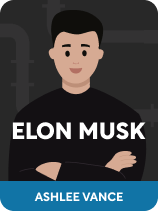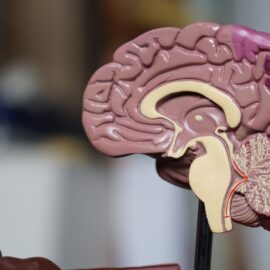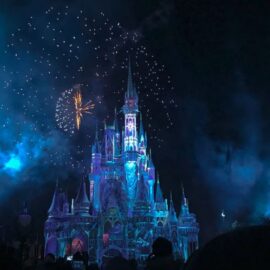
What was Elon Musk’s childhood like? How did he start his career? What’s his management style?
Walter Isaacson followed Elon Musk around for two years, gaining intimate access to his thoughts and activities. He interviewed those closest to him, including people now cut off from Musk’s circle. Musk exerted no editorial control, letting Isaacson draw his own conclusions.
Continue reading for an overview of Elon Musk by Walter Isaacson.
Overview of Elon Musk by Walter Isaacson
Elon Musk is simultaneously one of the most controversial figures of the modern age and one who’s done more than almost anyone else to push technology into the future. Spurred by childhood dreams of saving the planet while propelling humans into space, Musk made commercial spaceflight a viable business, brought electric vehicles into public awareness, and promoted a path to make artificial intelligence a benefit to the human race.
However, the way that Musk presents himself in the business world and the public sphere has led many to see him as irresponsibly disruptive toward society. His path to success has alienated colleagues and competitors, his intense drive and lack of empathy have routinely stirred up chaos in the companies he owns, and his need to control every aspect of his businesses has silenced productive criticism that may have benefitted Musk’s overall goals.
In our overview of Elon Musk by Walter Isaacson, we’ll follow Musk’s journey from a traumatic South African childhood, through his early successes to his establishment of SpaceX and Tesla, the companies that would define him. We’ll look at Musk’s complicated family life and his takeover of Twitter, an act that’s shaken Musk’s public perception.
Isaacson is a renowned biographer known for his works on Albert Einstein, Benjamin Franklin, and Leonardo da Vinci. In 2011, Isaacson published a definitive biography of Apple co-founder Steve Jobs, for which he was similarly given access to Jobs’s life, family, friends, and colleagues.
Elon Musk’s Beginnings
The insightful yet combative nature that would come to define Musk later in life had its roots in his early upbringing. Musk’s childhood was shaped by early trauma, compounded by the difficulties caused by his neurodivergence. Isaacson describes the abuse Musk suffered at home and at school, and how he was only able to escape through his love of science fiction and computing, the latter of which would enable him to start a new life on the other side of the world.
Musk was born in Pretoria, South Africa, on June 28, 1971. Because he was unusually smart as a child, he started school a year early, perhaps to his disadvantage. Musk had trouble making friends, in part due to his difficulty interpreting emotions and personal cues—a trait which Musk would later identify as a symptom of Asperger’s syndrome. Musk was regularly beaten at school, and, at home, both he and his mother endured Musk’s father’s relentless verbal assaults. Musk’s parents divorced when he was eight years old, and because his mother worked long hours to support them, he and his siblings had to fend for themselves.
Isaacson writes that, at the age of 10, Musk decided to live with his father, despite the nonstop verbal abuse, out of guilt that his father was living alone. Musk endured this period of his life by retreating into science fiction books and comics, in which he met characters out to save the world and started to dream about going to the stars. At this time, Musk also discovered video games and computers. He taught himself to write programs so well that by the age of 13, he was designing his own video games and selling them to computer magazines.
As Musk neared his high school graduation, he knew he had to leave his abusive father behind. Unfortunately, Isaacson suggests that Musk had developed some of his father’s traits—such as swinging rapidly toward dark moods with little warning and expressing his anger in vicious verbal tirades. Still, he wanted to spare himself and the rest of his family from his father’s influence. He moved to Canada with $4,000, where he worked on farms and lumber yards as he paved the way for his mother and siblings to join him. Once they were all reunited in Toronto, Musk took a job as a Microsoft intern and began his college career.
Early Ventures
From the start, Musk intuited a path that would align his skills and interests with his later successes in life. Musk used a solid educational grounding to create not one, but two successful software companies that propelled him to millionaire status. Isaacson shows that by combining software engineering with business in college, Musk was able to get an early edge in two growing markets—online business databases and Internet banking.
Though he considered pursuing a Ph.D. after graduating college in 1995, Musk worried he might miss the rising Internet boom and decided to go into business instead. With $40,000 in financial support from his parents, Musk and his brother Kimbal designed an online business database which they merged with mapping software, creating the first program where users could look up a business’s address and see it displayed on a map. Dubbed “Zip2,” their company consisted of a small team of engineers whom Musk drove hard to work long hours, setting an example by also driving himself nearly to the point of exhaustion. In 1999, Compaq bought Zip2 for $300 million, planting the seed of Musk’s next fortune.
Musk’s next goal was to start an online bank, which he launched as X.com. Musk and his rival, PayPal, flourished because the auction site eBay created the need for online payment platforms. However, X.com and PayPal both suffered during the dot-com crash, and Isaacson writes that to avoid a war of attrition, Musk and PayPal’s founders merged their companies into one bank that was X.com at its core, operating under the PayPal name. However, because Musk ignored warnings that PayPal was being used as a platform for financial fraud, the board removed Musk from his position of power. He still benefited to the tune of $250 million when eBay bought PayPal for $1.5 billion in 2002.
Rules for Business
By the time Musk started his next business venture, his management style was firmly established. Isaacson asserts that Musk’s leadership mindset is entirely mission-focused with an emphasis on challenging workers rather than nurturing them in any way. Central to Musk’s process is the creation of high-intensity work environments, a system for streamlining everything a business does or creates, and an outright denial that human empathy has any place in the pursuit of innovation.
High-Intensity Work Environments
According to Isaacson, Musk thrives on intensity and chaos and sees bringing that energy to his companies as a net positive. He achieves this by setting very tight and seemingly arbitrary deadlines for project objectives. To meet these deadlines, Musk encourages his teams to experiment, fail, and try something new, without being afraid to jury-rig solutions to problems. Musk’s deadlines force his managers and engineers to think creatively and simplify projects down to their basic principles, but they can also be demoralizing in the extreme, especially when team members believe Musk asks for things that are impossible to achieve.
Streamlined Systems
Isaacson writes that Musk’s workers often find that his high-speed deadlines are in fact achievable via Musk’s method of streamlining systems. First, he demands that engineers and designers question each supposedly necessary mandate, such as what materials to use, how many lines of code a program needs, or even what safety measures should be followed. Next, Musk demands that any process or component of a system that can be deleted should be. Once that’s been done, whatever’s left in a product or procedure should be optimized and accelerated.
No Room for Empathy
The third component of Musk’s management style, and the one that does perhaps the most to alienate the people Musk works with, is that Musk rejects human empathy as a valuable leadership skill. Musk has often said that managers who are friends with their workers can’t be good managers—they won’t be able to challenge their workers and give harsh, if necessary, feedback and criticism. Isaacson says that in Musk’s view, there’s a binary choice between protecting colleagues’ feelings and achieving goals. Musk himself has never been shy about confronting others in hard, unfiltered language, and while he’s used that to his advantage, those closest to him claim it’s a facet of Musk’s personality that he learned from his abusive father.
Musk’s Troubled Nature
Isaacson writes that Musk’s intense drive and sweeping accomplishments come at a personal cost, a fact that Musk freely owns up to. The psychological challenges Musk struggles with don’t determine every aspect of his personality, but they strongly color how other people view him. Among these are his difficulties understanding other people’s emotions and his need for constant, intense stimulation as a means to ward off depression.
Isaacson hints that Musk’s emotional development was stunted in childhood as a result of his father’s abuse—to survive, Musk learned to shut down his feelings. This, in combination with his Asperger’s traits, taught Musk to interpret emotions differently than those without such harsh backgrounds. Musk’s closest friends describe his childlike joy when he’s enthused by new ideas or projects, as well as his deep well of feelings for his family and loved ones. However, Musk has trouble with the feelings of others, which he approaches from an intellectual standpoint. Isaacson writes that when Musk feels threatened, he still shuts his feelings down in a heartbeat while using shows of anger to deflect the threat.
While shadowing Musk to research his biography, Isaacson noted that Musk doesn’t handle success very well. Instead of relishing his achievements, Musk craves crisis and thrives when he’s fighting for survival. This need is so strong that Musk will manufacture crises for his companies, such as setting arbitrary demonstration deadlines for products that aren’t yet finished. As mentioned before, these deadlines generate bursts of productivity, but they also force Musk and his teams to work round-the-clock shifts in a state of constant panic. Often, these periods of intense concentration are the only way for Musk to stay engaged and motivated without sliding into depression or risk-seeking behavior.
Musk the Pioneer
Despite his demons, or perhaps because of them as Isaacson sometimes suggests, Musk has arguably pushed technology forward more than any other living person in the modern age. In a way, Musk has made it his personal mission to bring human civilization to other worlds via his company SpaceX, while weaning us away from fossil fuels by developing electric vehicles through Tesla.
Musk fears the consequences of humanity being trapped on a single, fragile planet that’s endangered by the technology that we’ve used to advance ourselves. Isaacson writes that he’s also motivated by a sense of grandiosity—after all, who else will save the world if he doesn’t? In this context, Musk is driven by his mission. How to make that mission profitable is something he considers after the fact. Nevertheless, both SpaceX and Tesla have proven to be great financial successes, and while either business would be a crowning achievement, Musk believes in both so strongly that he can’t devote his attention to only one. As a technologist out to save the world, Musk served in part as the inspiration for the movie version of the superhero Iron Man.
SpaceX
After selling PayPal in 2002, Musk turned his thoughts to putting his fortune to the eventual goal of colonizing Mars, with the thought that humanity’s chances of survival would be increased by spreading out to other worlds. He founded SpaceX to take the incremental steps needed for that goal—building a reusable launch vehicle, proving that commercial spaceflight is a viable business, and designing rockets large enough to carry heavy payloads beyond the Earth’s orbit.
Musk’s first step was to build a reusable rocket that could launch satellites into orbit. Right away, Musk set unfeasible deadlines for a rocket launch in 2003 and an unmanned Mars mission in 2010. Neither of those goals were met, but in 2003, Musk presented his Falcon 1 rocket design and SpaceX was awarded its first government contract. Isaacson recounts how that wasn’t enough for Musk, who knew that most space industry companies received noncompetitive no-bid contracts for their work regardless of how well they performed. Musk sued NASA, arguing that no-bid contracts stifled innovation while propping up failing aerospace companies. Musk’s suit opened the door to competitive private bidding for space projects.
After that, the history of the Falcon 1 was a string of lessons learned from mistakes. The first three Falcon 1 flights exploded shortly after liftoff, but each failure gave SpaceX more information about what worked and what didn’t in their design. The fourth SpaceX flight was successful, proving that a private company could send payloads into space at a fraction of the cost and manpower employed by enormous government contractors. In 2008, SpaceX won a $1.6 billion contract to ferry cargo and crew to the International Space Station (ISS).
Fulfilling SpaceX’s new contract required a much bigger rocket. The result was the Falcon 9 and its recoverable capsule, the Dragon. The Falcon 9’s inaugural flight set the record for the largest rocket ever safely landed—those designed by rival aerospace companies were made to burn up in the atmosphere after use. Making the Falcon 9 successful required last-minute fixes and patches that would have caused NASA weeks of delays. Isaacson says that Musk’s tolerance for risk enabled SpaceX to solve problems quickly in ways that cumbersome organizations couldn’t. The Falcon 9’s success culminated in its 2020 flight of two astronauts to the ISS, the first manned American launch since the end of the Space Shuttle program in 2011.
Starlink
Funding an aerospace company isn’t easy. To do so, Musk launched Starlink, a satellite-based internet service provider. Though he never meant for Starlink to be used for military purposes, in 2022 Musk donated thousands of Starlink terminals to help restore Ukraine’s communication network during the Russian invasion. This he did for humanitarian reasons, and Starlink proved vital to holding back Russia’s advance, but Isaacson writes that Musk deactivated part of Ukraine’s Starlink access when they planned to use it in a counterattack. Musk feared that an escalation in the war might trigger a Russian nuclear response and decided that Starlink should only be used for purely defensive operations.
Tesla
Musk’s other dream besides leaving the Earth was saving the Earth by ending society’s fossil fuel addiction. Musk believed an energy-efficient future was just as vital to humanity’s survival as space exploration, and he chose to make an impact by bringing electric cars into the mainstream. Isaacson details how Musk entered the automotive industry with Tesla, based all of its production inside the US, and pushed its technology in the direction of fully automated, self-driving cars.
In 2003, Musk began meeting with entrepreneurs in the electric car industry. Tesla was the brainchild of Martin Eberhard, who’d licensed an electric motor for a high-end sports car that he didn’t have the funding to build. Musk provided the money and took charge of many of the car’s technical details. Tesla came together with Musk as the board chair and Eberhard as CEO, but clashes began because Eberhard and Musk each thought of himself as Tesla’s founder. Isaacson writes that Musk was incensed when the press painted him as a “mere investor,” so he took it upon himself to proselytize the company’s mission—disrupting the gas-guzzling automobile market with affordable, high-quality electric vehicles.
Musk took a more active role in managing Tesla’s production process, and he found that the company’s supply chain was a disaster. Its parts were manufactured all over the world and then shipped from country to country as the car’s components were assembled piecemeal. When Musk calculated how much each car cost, factoring in worldwide shipping and assembly, he realized that Tesla would quickly go bankrupt. He quickly moved to have Eberhard fired and eventually took over as CEO himself. Isaacson says that Musk’s primary focus was to centralize production so he could control the process from start to finish, going so far as to sleep on the factory floor as he stayed day and night to solve production problems.
To bring about the future he imagined, Musk didn’t only want an electric car, but one that could drive itself. In tune with Musk’s habit of setting aggressive deadlines, Isaacson writes that for over a decade, Musk has publicly declared that self-driving cars are a year or two away, and advances in machine learning are close to fulfilling Musk’s ambitions. Instead of driving based on preprogrammed “rules of the road,” new systems learn by observing the best human drivers and how they react in all situations. As a result, in 2023, Musk rode a self-driving Tesla on a 30-minute trip around Palo Alto without ever touching the steering wheel or brakes.
Musk’s Family Life
The energy, passion, and frustration Musk expresses in the boardroom and on the factory floor are matched by the tumult he also brings into his private relationships. Isaacson says that just as in business, Musk seeks out intensity and chaos in his personal life. Musk has had turbulent relationships with the author Justine Musk (née Wilson), the actress Talulah Riley, and the musician Grimes, and has fathered 11 children whom he dotes on save for one from whom he’s publicly estranged.
Justine and Musk were acquainted in college, but they reconnected and married around the time of the sale of Musk’s first business. According to Isaacson, Justine was attracted to Musk because he was passionate about solving problems more than making money. She enjoyed fighting as much as Musk did, but after the sudden death of their infant son, Musk shut down all displays of emotion and berated Justine when she expressed hers. The couple had five more children through in vitro fertilization, but over time Justine felt that Musk used their fights as a substitute for personal connection, and she filed for divorce in 2008.
Shortly after his first marriage ended, Musk met the actress Talulah Riley, and within two weeks they were engaged—though they wouldn’t marry for two years. Isaacson says that Musk was self-aware enough to let Riley know that life with him would be hard. Nevertheless, while their marriage lasted, it was one of the few stable things in Musk’s life. Despite Musk’s often unfeeling exterior, Riley says that inside, Musk feels things quite strongly and retains a boyish excitement for the things that bring him joy. Their first marriage lasted until 2012, but they quickly remarried and stayed together until 2015, when they split for good.
During 2018, which was a rough year for all of Musk’s business ventures, he met the musician Claire Boucher, known as Grimes. The two shared many common interests, and like Musk, Grimes was attracted to chaotic relationships. However, Isaacson writes that Grimes possesses a streak of kindness that had long been missing from Musk’s life. Though the two ended their romantic relationship in 2021, they remain involved with each other as friends and co-parents of their children.
Musk’s Children
In total, as of this book’s publication, Musk has fathered 11 children—six with his first wife, Justine Musk, three with his partner Grimes, and two with business executive Shivon Zilis for whom he served as a genetic donor. His first child, Nevada, died in 2002 from Sudden Infant Death Syndrome. His first child with Grimes—a boy named X—was born in 2020 and was almost inseparable from Musk during the time that Isaacson spent with him. According to Isaacson, Musk is very vocal about the need to keep population numbers up to preserve human consciousness in the face of growing artificial intelligence, and that he’s just doing his part to maintain the species.
The only child with whom Musk’s relationship is strained is his transgender daughter Jenna, who Isaacson reports has disavowed her connection with Musk due to her perception of his anti-transgender views and because of her anti-capitalist political beliefs.
The Twitter Saga
As Jenna became vocal about her left-leaning political views, the 2020s marked an apparent shift in Musk’s politics toward a strongly conservative stance. An avid user of the Twitter platform, Musk began to feel that its policies for banning users and promoting certain messages were skewed by a heavy liberal bias. To resolve this, Musk decided to get involved himself, first by influencing Twitter by investing, and then later by buying it outright. Isaacson describes Musk’s early interactions with Twitter’s board of directors, his rapid decision to purchase the entire platform, and his last-minute cold feet about closing the deal.
Isaacson theorizes that part of the reason behind Musk’s interest in Twitter was the unrivaled success that Tesla and SpaceX were experiencing in 2022. The calm and ease that came with success didn’t sit well with Musk’s disposition, but instead of igniting new projects at those companies, he dove into Twitter instead, encouraged by a circle of libertarian friends who, like Musk, wished to see Twitter’s content policies relaxed. Based on the size of his investment in the company, Musk approached Twitter about membership on the board but quickly realized that sharing power that way wouldn’t allow him to make sweeping changes.
Isaacson writes that, rather than joining the board, Musk offered to purchase Twitter for $44 billion. Musk believed he could make Twitter profitable by offering validated user accounts for a monthly fee, as well as turning Twitter into a financial platform on which artists and creators could get paid for work they posted. Musk also wanted to democratize Twitter by removing all censorship and making its algorithm for content promotion open source and available to the general public. Beyond that, Twitter was something Musk loved as an arena for dramatic, unfiltered expression.
However, after Musk had time to think about the deal, he started to feel that he was overpaying. Isaacson says that one crucial point was the number of fake Twitter accounts, which Musk believed the company severely undercounted. Musk had analysts comb through Twitter’s data to find out how many of the accounts were real, and when they couldn’t make a determination, Musk tried to back out or at least drop the price. Twitter sued to make Musk follow through on his agreement, but Musk got the last twist of the knife by closing the deal a day sooner than expected and firing Twitter’s executives before they could use their stock options. Musk believed they’d misrepresented Twitter’s value, and therefore his actions were justified.
The Challenges of Twitter
By taking over Twitter, Musk triggered a seismic shift in the social media landscape. The culture at Twitter and Musk’s leadership style were diametrically opposed in almost every way, resulting in a clash of ideals that upended the character of the social media platform. Musk disrupted the Twitter status quo by laying off the majority of its staff, reframing its content and account-holder policies, and reinstating many banned accounts that had been blocked for violating Twitter’s previous rules.
Isaacson explains that, prior to Musk’s takeover, Twitter’s culture emphasized inclusivity, caring for employees, and psychological safety in the workplace—all of which went against Musk’s crisis-based, aggressive management style. The first thing Musk did was to have teams from SpaceX and Tesla evaluate Twitter’s software engineering department with an eye toward reducing the company’s size. Layoffs targeted inefficient coders, staff who were potentially disloyal to Musk, and anyone who wasn’t willing to maintain the frantic pace of work that Musk preferred. The latter round of layoffs was self-driven—Musk explained his workplace expectations and gave Twitter’s remaining staff the option to “opt in” or take severance.
Musk’s next move was to halt what he saw as Twitter’s censorship of free speech, but Isaacson says that Musk quickly learned that “free speech” isn’t a simple issue. As soon as Musk took over the platform, it was swarmed by online bots posting offensive content, testing the limits of what Musk would allow. Musk had his staff shut down the attack while he leaned into creating paid, verified accounts as a means to filter out bad-faith actors, but that strategy also proved problematic—users could pay for a verified account, then change their account after the fact to impersonate another person or business.
Addressing Twitter Censorship
Musk still believed that Twitter’s old content policies had gone too far in response to such misuse of the site. To prove it, he invited journalists to pore through Twitter’s moderation policies and records. They discovered that not only did Twitter have a left-leaning bias, it had worked with the FBI to decide what information should be blocked or hidden. In some cases, Isaacson reports that this had gone beyond barring hate speech and misinformation to the outright silencing of voices that didn’t agree with mainstream thought.
Isaacson writes that in November 2022, Musk began reinstating accounts—both conservative and progressive—that had been banned by Twitter’s previous management, including that of former president Donald Trump, of whom Musk wasn’t a personal fan. An unintended consequence was that advertisers started leaving the platform, cutting into Twitter’s bottom line. Musk didn’t help matters by making impulsive tweets of his own, some of which amplified conspiracy theories or targeted former Twitter employees. The damage done to Twitter’s brand started to spread to Musk’s other companies and his reputation. Musk realized that dealing with Twitter was negatively impacting his mental state, and buyer’s remorse began to set in.
In Isaacson’s first-hand analysis of the Twitter takeover and its fallout, he suggests that Musk’s fundamental mistake was treating Twitter as a technology platform, rather than a network for leveraging emotion. Musk tried to rebuild Twitter the way he’d design a rocket or a car—by cutting pieces off, seeing if it explodes, putting it back together, and trying again. This strategy worked well in Musk’s previous endeavors, but not so much in the realm of social media. And yet, though many outside observers have repeatedly predicted Twitter’s collapse, as of the time of this book’s publication, that still hadn’t come to pass.
Musk and the Future
Despite the distractions and disruptions at Twitter, Musk’s other companies have still been working hard to constantly push technology forward. Isaacson insists that Musk still views bringing about a positive future for humanity as his primary mission in life. To achieve this, his teams have been developing computer chips to enhance human brains, AI-driven robots to perform manual labor, and a spacecraft capable of taking astronauts to Mars.
In 2012, Musk began to ponder the threats represented by unchecked artificial intelligence. To keep AI aligned with human values and progress, and so it can enhance us rather than replace us, Musk created Neuralink, a company to research and design computer chips to directly connect the human mind to computers. Isaacson explains that the immediate benefits would be to help people with neurological disorders regain control of their bodies. However, Neuralink’s end goal is still to create a seamless mind-machine interface so that AI can add to human consciousness. As of 2023, thanks to its progress—such as enabling a macaque to play video games with its mind—Neuralink’s technology has been approved for human trials.
Another AI-based project that Musk has taken on is the Optimus project to build human-friendly robots capable of performing any physical task. Isaacson says that Musk sees such robots as a benefit to society—they could remove the drudgery of human labor, allowing people to spend their time pursuing educational and creative projects. By giving AI a physical presence, rather than disembodied language programs such as ChatGPT, Musk believes humanoid robots are a necessary step in the next level of AI development, one that will align AI’s interests with those of the physical world.
Lastly, Musk has never wanted to be stuck in only one world. Colonizing Mars has always been his highest goal, and the next step in achieving that ambition is SpaceX’s Starship rocket, a reusable spacecraft larger than the Saturn V that launched Apollo to the moon. The first Starship test flight took place in April 2023. The rocket cleared the launchpad and almost made it into space before an engine problem aborted the mission. Isaacson makes it clear that Musk and his staff didn’t see this as a failure but as a learning success. Data taken from this initial flight will be used to improve future Starship rockets, perhaps one day sending astronauts back to the moon and beyond.

———End of Preview———
Like what you just read? Read the rest of the world's best book summary and analysis of Ashlee Vance's "Elon Musk" at Shortform.
Here's what you'll find in our full Elon Musk summary:
- A biography of Elon Musk by renowned biographer Walter Isaacson
- Musk's traumatic South African childhood up until his Twitter takeover
- How Musk's Asperger's syndrome affected his childhood and relationships






